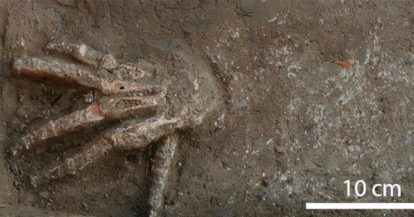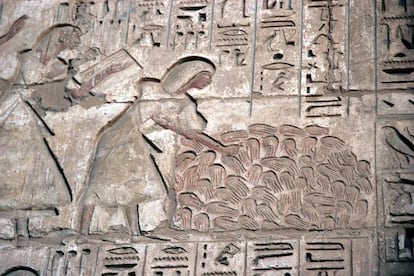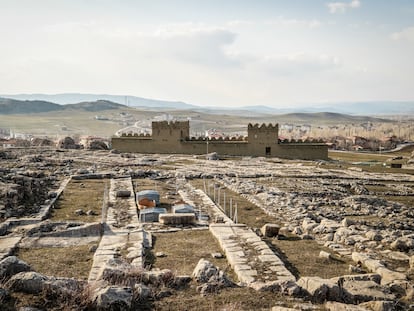
Severed hands for the pharaoh: Archaeologists find first physical evidence of enemy mutilation in Ancient Egypt
Amputated limbs, which according to sources were used to count dead warriors, have been excavated from three pits in a 15th dynasty palace at Avaris

In Ancient Egypt, the hands of enemies fallen in battle were cut off as war trophies and for the more practical purpose of accurately counting casualties. Documents and reliefs found in tombs and temples attest to this practice. In Ramesses III’s temple in Medinet Habu (Luxor, Egypt), soldiers are depicted carrying sacks and baskets full of severed hands to present to a pleased pharaoh. Mika Waltari’s historical novel The Egyptian (1945) described the practice in a gory battle scene, pitting Egyptians against the Jews of Khaybar (northern Arabia). Horemheb’s victorious troops deposit a tall, macabre pile of severed right hands at the feet of their commander and a statue of Sekhmet, the lion goddess of the war. The best warriors bring three, four, and even five bloody limbs. Then came the count, which provided a measure of victory and a basis for rewarding soldiers with gold jewelry.
Similar scenes are found in other historical novels, like Norman Mailer’s Ancient Evenings (1983). Mailer describes soldiers who are punished for cutting off the hands of prisoners or, even worse, from their own dead comrades (a hand is a hand, after all). The Jewish way of counting was more precise. According to the Old Testament, they would cut off the foreskins of their uncircumcised enemies. Ancient Egyptian icons and bas-reliefs attest to their practice of collecting penises from dead enemies on the battlefield (a bas-relief in Medinet Habu shows this, although many visitors miss it). Ears were collected at times too, long before US Marines did so in Vietnam, again proving there is nothing new under the sun.
Most histories of Ancient Egyptian warfare mention the severing of hands, including Bridget McDermott’s Warfare in Ancient Egypt (2004), which describes the tomb of a soldier named Ahmose, son of Abana, that is inscribed with an account of the many hands he presented to the pharaoh, who rewarded him with slaves and land. But no one had ever found any physical evidence of this well-documented practice – until now.

A paper published on March 31 in Scientific Reports presents the first osteological evidence of severed hands in Ancient Egypt. The severed right hands of 12 individuals were excavated in three pits within a courtyard in front of a throne room of a 15th Dynasty (c.1640–1530 BC) Hyksos palace at Avaris/Tell el-Dab’a in northeastern Egypt. “Although this kind of practice is known from tomb or temple inscriptions and reliefs from the New Kingdom onwards, this is the first time that physical evidence has been used to learn more about the procedure and the individuals whose hands were taken,” write the authors (Julia Gresky, Manfred Bietak, Emmanuele Petiti, Christian Scheffler and Michael Schultz).
The bioarchaeological analysis of these human hands provides a third source of evidence (additional to iconographic and archaeological evidence), and offers unique insights into unknown details of this practice. The war trophies are ghoulishly presented with outstretched fingers – there is no mistaking them for anything but human hands. The three pits where they were excavated contained one, three and eight hands, respectively. In the two pits with multiple specimens, several individual fingers were found, so that the total number of hands may amount to 18. Curiously, one appears to belong to a woman. The others belong to men of military age – adults, but not elderly men. Eight of the complete hands were placed palm down, and three were palm up. All had been cleanly severed from the forearm.
An analysis of the hands found they were not immediately deposited in the pits because rigor mortis had partially set in, but the fingers were still pliable enough to be stretched into a presentable position. The hands still had ligaments and tendons that kept the bones in place when they were buried. The authors of the study write that the location, treatment, and possibly the positioning of the severed hands argues against the hypothesis of law-enforcing punishment as the motivation for these acts. Considering the many other archaeological and historic sources, the bioarchaeological evidence presented in the paper suggests that the severed hands were offered as trophies. The amputation of hands is not found in other Ancient Egyptian contexts except in some looting cases when the hands of mummies were cut off to remove jewels (for example, the mummy of Seti II is missing the right limb). Nor did it make much sense to cut off prisoners’ hands because it would make them useless as slaves.

Since the hands were excavated from pits in front of a royal throne room, the study authors concluded they were placed there as part of a public event that took place in the palace, perhaps for rewarding valiant warriors. None exhibit cut marks or any evidence of soft tissue removal, which implies that these hands were precisely severed and prepared for presentation.
Although the hands cannot be attributed to a specific ethnic or cultural group, the custom of severing the right hands of foes appears to have been introduced to Egypt by the Hyksos. The Egyptians adopted this custom in King Ahmose’s reign, as shown by a relief of a pile of hands at his temple in Abydos. Ahmose was the one who conquered Avaris and defeated the Hyksos and was likely familiar with this practice. Early 18th Dynasty tomb inscriptions and temple reliefs from the 18th to the 20th Dynasties consistently depict hand counts on battlefields. According to the study, there is linguistic evidence that the practice of severing enemy hands originated in the Near East. During the early 18th Dynasty, a new hieroglyph appears with the first inscriptional mention of the cutting of hands in warfare. It is not the typical hieroglyph for hand, but a very realistic representation of an outstretched palm that may signal a new word – severed hand.
Sign up for our weekly newsletter to get more English-language news coverage from EL PAÍS USA Edition
Tu suscripción se está usando en otro dispositivo
¿Quieres añadir otro usuario a tu suscripción?
Si continúas leyendo en este dispositivo, no se podrá leer en el otro.
FlechaTu suscripción se está usando en otro dispositivo y solo puedes acceder a EL PAÍS desde un dispositivo a la vez.
Si quieres compartir tu cuenta, cambia tu suscripción a la modalidad Premium, así podrás añadir otro usuario. Cada uno accederá con su propia cuenta de email, lo que os permitirá personalizar vuestra experiencia en EL PAÍS.
¿Tienes una suscripción de empresa? Accede aquí para contratar más cuentas.
En el caso de no saber quién está usando tu cuenta, te recomendamos cambiar tu contraseña aquí.
Si decides continuar compartiendo tu cuenta, este mensaje se mostrará en tu dispositivo y en el de la otra persona que está usando tu cuenta de forma indefinida, afectando a tu experiencia de lectura. Puedes consultar aquí los términos y condiciones de la suscripción digital.
More information
Últimas noticias
Most viewed
- Reinhard Genzel, Nobel laureate in physics: ‘One-minute videos will never give you the truth’
- Oona Chaplin: ‘I told James Cameron that I was living in a treehouse and starting a permaculture project with a friend’
- Pablo Escobar’s hippos: A serious environmental problem, 40 years on
- Why we lost the habit of sleeping in two segments and how that changed our sense of time
- Chevy Chase, the beloved comedian who was a monster off camera: ‘Not everyone hated him, just the people who’ve worked with him’










































